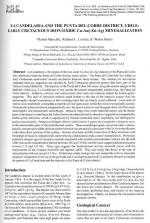Добрый день, Коллеги. Важное сообщение, просьба принять участие. Музей Ферсмана ищет помощь для реставрационных работ в помещении. Подробности по ссылке
La Candelaria and the Punta del Cobre district, Chile: early cretaceous iron-oxide Cu-Au(-Zn-Ag) mineralization
La Candelaria is the largest of the iron oxide Cu-Au(-Zn-Ag) deposits in the Punta del Cobre belt, which also hosts the Punta del Cobre district, sensu strictu. The Punta del Cobre belt lies within an Early Cretaceous continental volcanic arc/marine back-arc basin terrane. The volcanic arc and marine carbonate back-arc sequences are intruded by Early Cretaceous granitoid plutons that form part of the Chilean Coastal Batholith. The deposits of the Punta del Cobre belt occur along the eastern margin of the batholith within (e.g., La Candelaria) or just outside the contact metamorphic aureole (e.g., the Punta del Cobre district). Andesitic volcanic and volcaniclastic host rocks are intensely altered by biotite-quartz-magnetite. This style of alteration extends much further to the east of the intrusive contact than the metamorphic mineral associations in the overlying rocks that are clearly zoned outboard. Local areas of intense calcic amphibole veining that overprints all rock types occur within the contact metamorphic aureole. Chalcopyrite mineralization is paragenetically late, because it crosscuts and thus post-dates all of the major metamorphic and metasomatic assemblages. Deposits lying close to the batholith contact and the deeper parts of the deposit in the Punta del Cobre district are characterized by abundant magnetite accompanied by biotite-quartz alteration, which is superposed by fracture-controlled calcic amphibole, and chalcopyrite-pyrite mineralization. Potassium feldspar-chlorite and/or biotite + quartz plus magnetite ± hematite occur in the intermediate parts of the hydrothermal system. These assemblages grade up-section and, in places, laterally into pervasive albite-chlorite-calcite-hematite that are spatially associated with Cu-Au mineralization in the more distal portions of the system. Tectonic structures and the intersection of these structures with the contact of massive volcanic rocks and overlying volcaniclastic rocks control mineralization. Previously published isotopic ages of alteration minerals associated with metallic mineralization indicate that the bulk of the iron oxide mineralization formed between 116 and 114 Ma, and the main copper-gold mineralization between 112 and 110 Ma. These ages suggest that hydrothermal activity occurred coeval with the emplacement of the Copiapo Batholith and regional uplift. They also imply that burial at the time of mineralization did not exceed 2-3 Km. Preliminary stable isotope data are compatible with an important magmatic component in the ore-forming fluids and a cooling/mixing model is presently favored to explain the genesis of La Candelaria and the deposits in the Punta del Cobre district.




